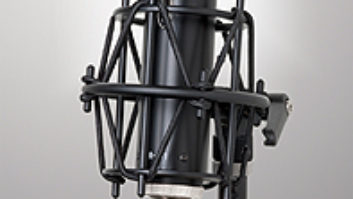
It’s seldom that a truly unique audio product comes onto the market, but the Manley MicMAID is one-of-a-kind. Simply put, it is a router that allows for quick recall of any single combination of four mics and four preamps at the push of a button. For instance, you can have a single mic and audition it across four preamps, or conversely, have four mics and audition them across a single preamp, or any combination up to 4×4.
On the back, XLR I/O is plentiful, featuring four mic inputs, four outputs to preamps, four preamp returns and four preamp direct outs. The key to the whole system is the single MON/REC output, which lets you run any mic/preamp combination to a single channel of your recorder. This output is also the only way to take advantage of the infinitely variable phase control and ±19.5 dB level matching gain trim (in 0.5dB steps) on each preamp’s output. The phase control feature comprises a 180-degree Polarity Flip button, Bypass button, and a High and Low band button. It uses an active all-pass filter network with a capacitor inserted to change the crossover frequency when the High switch is engaged.
Front-mounted features include DI input and Thru (on TS jacks), ground lift switch, fader input for riding levels to your recorder, variable phase controls, 4×4 matrix switcher, four mic switches, an Instrument input toggle, four phantom power buttons, a “Lock” feature, and a gain trim knob that doubles as a menu controller.
CLEAN MACHINE
Although the box is a simple router in concept, there are some things to get your head around. For instance, to keep the user from switching 48 VDC whenever a different mic is selected, phantom power can only be applied from the MicMAID itself. This keeps clicks and pops from happening while switching mics/preamps and protects mics, like ribbons, from accidentally receiving phantom power. When phantom power is not engaged, it’s a hard-wire connection from input to output. When the MicMAID is providing phantom power, there is just one capacitor in the signal path, offering negligible change in impedance and phase. MicMAID will sense and block any incoming phantom power displaying “bP” (bad phantom) if it detects phantom coming from a connected preamp. It will temporarily disable the signal path where it senses phantom, and the corresponding PRE button in the matrix flashes until the offending voltage is turned off at the preamp. After a short delay, the unit will unmute and become operable again.
Wanting to be sure I wasn’t skewing results by inserting the MicMAID into my review chain, I put the unit on the bench and ran some tests with an Audio Precision APx500 system. The folks at Manley boast a clean signal path throughout, and they’re not fibbing. (See full test results at mixonline.com). From preamp in to out, with the Variable Phase inserted, the APx500 measured distortion at a slight 0.008 percent and 0.003 percent without the variable phase feature engaged. It is dead-flat out to 10 kHz and only 1.75 dB down at 80 kHz. With gain trim at full volume +24.167 dBm (at 600 Ohms), the distortion figures were the same and the unit was still flat out to 10 kHz, but only -2.5 dB at 80 kHz.
The MicMAID is marvelous in use. You can quickly jump between setups and then lock a mic to a preamp. I especially liked the gain- matching controls and how easily it allowed me to compensate for level changes between preamps and mics. You can store setups internally for future use, and although I didn’t use it, the option to add a fader to the output is brilliant.
AM I A MAID MAN?
The Manley MicMAID is a mind blower. It does what all great gear is supposed to do: disappear after setup and reveal the truth beyond the box. This product does something that once was impossible: offer users the ability to audition different mic/preamp combinations in succession without patching or delay. I was able to get a bead on my front end signal chain in short order and make better recording decisions. I found mic/preamp combinations that worked, then moved on to other applications where I found more. There were occasional clicks when I switched mics during high transient peaks, but that was rare and negligible. The MicMAID gets high marks in all sonic categories and makes you a better engineer, and you’ve got to love that.

Click on the Product Summary box above to view the MicMaid product page.







